#rauisuchian
Explore tagged Tumblr posts
Text


A very experimental Prestosuchus drawing, using a lot of brushes that ive not used before.
133 notes
·
View notes
Text

Reimagined take on fasolasuchus from the movie 65
i refuse to even believe this thing is supposed to be a Fasolasuchus with how horrid this design is in the movie and like how i described it in my previous post it literally looks like an Indoraptor if it sacrified intelligence for size, so my hatred of the monster from the movie aside i wanted to make a spec evo take on this thing and since the rauisuchian is the general consensus i made this thing into a rauisuchian and its not fasolasuchus i gave this thing its own genus a lazy one that is called "Tyrantosuchus emperatus" and it is the last surviving member of the rauisuchian till the KPG extinction 66 million years ago!
Tyrantosuchus are a genus of massive rauisuchian from the maastrichian age of the cretaceous period 68 to 66 million years ago in Hell Creek, they are large facultative bipdelal predators reaching a height of 3.81 meters (12.5 ft) at the hips, Length of 16 meters (52.49 ft) and weighs 4 tons it is the largest rauisuchian and it is the second largest land predator in hell creek!

Tyrantosuchus are facultative bipeds mostly quadrupedal but sometimes they do go on a bipedal stance when needed,
Tyrantosuchus are one of the fastest large predators ever being able to run up to 48 Km (20milles) per hour to catch large prey like Edmontosaurus but they more hunt smaller prey such as champsosaurus or adolescant t rexes, younger individuals hunted smaller prery closer to their size like Anzu or Ornithominus!
Tyrantosuchus live in solitary life only coming together when mating and younger individuals spends time climbing on trees to escape from large predators!

this is my own take on this big monster from the trash movie, let me know your thoughts on this and hopefully its better than what 65 came up! ^w^
also if y'all like to see more stuff like these i can accept requests just dont go crazy on them i might not be able to do all of them
10 notes
·
View notes
Text








Saurosuchus is an extinct genus of large loricatan pseudosuchian archosaurs which lived throughout what is now South America during the Late Carnian to Early Norian stages of the Triassic period around 232 to 225 mya. The first remains of Saurosuchus consisting of a complete albeit deformed skull was unearthed in 1957 from the greenish sandstone on the Cancha de Bochas Member of the Ischigualasto Formation in the Ischigualasto-Villa Unión Basin of northwestern Argentina by Galileo J. Scaglia and Leocadio Soria. This specimen was formally described in 1959 by Osvaldo. A. Reig who named the animal Saurosuchus meaning lizard crocodile in greek. The specific name, galilei, is in honour of Galileo J. Scaglia. Since then several more specimens of Saurosuchus have been recovered including some partial skeletons and a mostly complete juvenile. Reaching around 18 to 23ft (5.5 to 7m) in length and around 1,300lbs (590kgs) in weight, saurosuchus was one of the largest rauisuchians. It sported a deep, laterally compressed skull, and jaws filled with large, serrated, re-curved teeth. The neck was short but robust, the tail long and strong, with both the front and back legs being long and heavy built for walking. This quadrupedal carnivore was likely the apex predator of the Ischigualasto Formation living alongside and likely feeding upon creatures such as Hyperodapedon, Exaeretodon, Herrerasaurus, Sillosuchus, Eoraptor, Trialestes, Aetosauroides, and Ischigualastia.
Art used can be found at the following links:
#pleistocene pride#pliestocene pride#triassic#saurosuchus#ischigualasto formation#rauisuchian#crocodile#south america#mesozoic#archosaur#pseudosuchian
4 notes
·
View notes
Text
youtube
0 notes
Text
Archovember 2024 Day 27 - Tanystropheus longobardicus
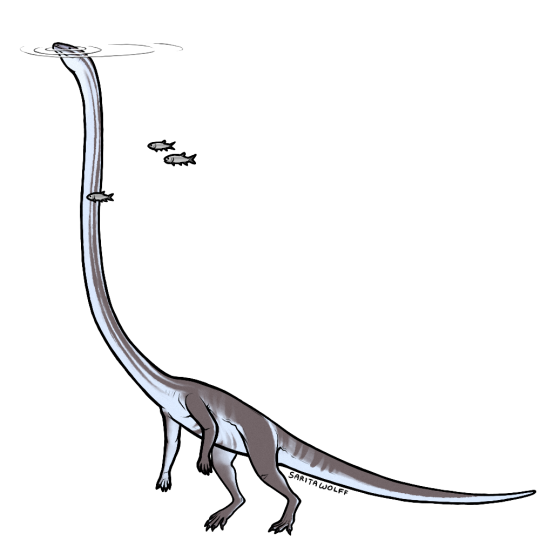
Our last non-archosaur archosauromorph of this Archovember (say that 5 times fast) is Tanystropheus longobardicus. This archosauromorph lived in the Middle Triassic of what is today the border of Italy and Switzerland. It’s most recognizable feature is its long neck, made up of 13 lengthened vertebrae, that stretched out longer than its body and tail combined! What it was doing with this long neck is the subject of debate. The neck was not very flexible, made of long, stiff vertebrae, though it was lightweight and stabilized by tendons. Tanystropheus was likely a fish-eater, with T. longobardicus in particular being equipped with three-cusped teeth suited for holding onto slippery prey, and fish scales and cephalopod hooklets have been found in the stomach region of some specimens. Its body did not seem to have many adaptations for swimming, though its muscular hindlimbs and tail may have allowed for short bursts of active swimming in shallow water. It’s hypothesized that Tanystropheus was a semi-aquatic ambush predator, either using its long neck to reach across the water and snap up fish like a heron, or waiting in the water like a turtle, its body unseen and long neck appearing like an innocent branch.
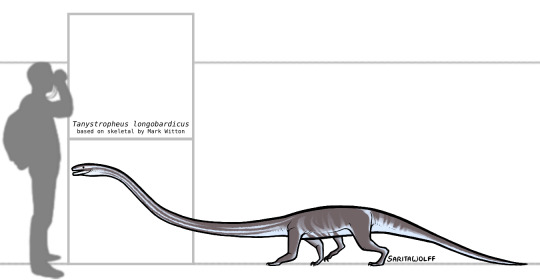
Tanystropheus longobardicus was the smallest of the known species of Tanystropheus. It lived alongside the larger, bulkier T. hydroides, while even larger Tanystropheus specimens have been found in Germany and Poland. Fossils have also been found in Canada and China, meaning this genus may have had a worldwide distribution. But T. longobardicus in particular lived in the Besano Formation. It was set apart from the larger T. hydroides by its small size, narrow triangular head, and tricuspid teeth in the back of its skull. Meanwhile, the larger T. hydroides had a broader skull and long interlocking fangs. The two species likely did not compete, as T. hydroides would have preferred much larger fish than T. longobardicus. But these were not the only tanystropheids in the Bessano Formation. They would have also lived alongside the smaller, shorter-necked, terrestrial tanystropheid Macrocnemus bassanii. On land, Tanystropheus longobardicus would have had to worry about the early rauisuchian Ticinosuchus. In the sea, Tanystropheus would have had to look out for the nothosaur Nothosaurus, large thalattosaurs like Askeptosaurus, large predatory fish like Birgeria, and even large icthyosaurs like Besanosaurus and Cymbospondylus. It may have also come across smaller icthyosaurs like Mixosaurus, Phalarodon, and Wimanius, as well as placodonts like Cyamodus and Paraplacodus, pachypleurosaurs like Serpianosaurus and Odoiporosaurus, and other reptiles like Silvestrosaurus, Helveticosaurus, and Eusaurosphargis. It could have eaten small fish like Aetheodontus, Cephaloxenus, and Luganoia, and even small coelocanths like Ticinepomis.

This art may be used for educational purposes, with credit, but please contact me first for permission before using my art. I would like to know where and how it is being used. If you don’t have something to add that was not already addressed in this caption, please do not repost this art. Thank you!
#Tanystropheus longobardicus#Tanystropheus#tanystropheid#archosauromorphs#reptiles#Archovember#Archovember2024#Dinovember#Dinovember2024#SaritaDrawsPalaeo#Middle Triassic#Italy#Switzerland#Bessano Formation
54 notes
·
View notes
Text
Fossil Crocs of 2023
2023 has been a year with its ups and downs, but one consistent thing has been its fossil crocs at least, giving us another interesting variety of species and genera not known before. Like last year, I'll go down each of them (including phytosaurs) and give you some key notes. And since I've done my best to make individual posts for them I'll link those when available. I'll also try to give translations where possible, but do note that sometimes I might switch around a word due to it just sounding awkward otherwise.
Scolotosuchus
Starting us off is Scolotosuchus basileus ("royal scythian crocodile"), a basal, rauisuchian-like animal from the early stages of the Triassic. An animal roughly 3 meters long, it is primarily known from vertebrae and some other material, which however does have interesting implications. Based on the anatomy of the vertebrae, it has been speculated that Scolotosuchus performed a lot of rapid movement of the neck, presumably while hunting. Furthermore, it might be that Scolotosuchus lacked osteoderms, instead having developed a bracing system for its body much more like that of dinosaurs and mammals. Artwork by @knuppitalism-with-ue (he'll pop up quite a lot)
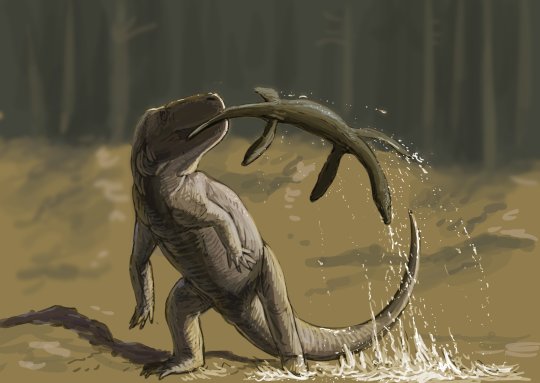
Colossosuchus
Fast forward to the Late Triassic, the hayday of early Pseudosuchians, and we find our first phytosaur of the list. Colossosuchus techniensis ("colossal crocodile of the Indian Institute of Technology") was an enormous animal from India's Tiki Formation. This one is known from undisputably better material, perhaps some of the best on this list as we have an entire bone bed of these guys, possibly representing a mass death site. Size estimates of the large specimens generally range from 6 to 9 meters in length, also making it the largest animal of this list, with the authors favoring an estimated 8 meters for the largest individual. Of course this is all subject to change, as we don't know the precise proportions (the downside of a bone bed is that all the bones are kinda jumbled together and god knows what belongs to what). Artwork by Joschua Knüppe again, a female being courted by an overconfident and confused Volcanosuchus (told you so)

Kryphioparma
Ok I won't bother you with this one too much. Kryphioparma caerula ("blue mysterious shield") is an aetosaur from the Late Triassic Chinle Formation of Arizona. Now aetosaurs are cool of course, but the thing is that Kryphioparma is known from exclusively osteoderms, their large armour plates. While thats valid, its also not really exciting (as you could have guessed from the absolute lack of artwork). Best I can say is that it coexisted with a bunch of other aetosaurs, which surely would have been a sight to see back in the day.
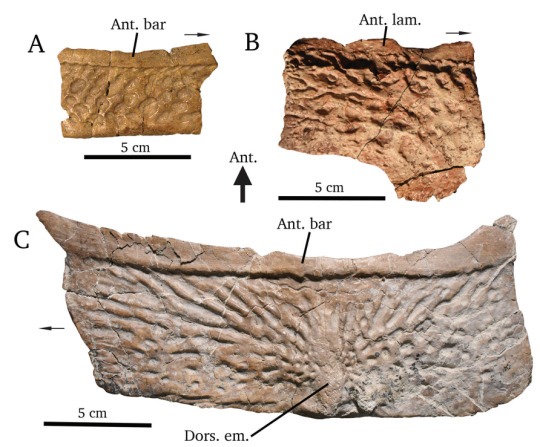
Venkatasuchus
Now Venkatasuchus armatum ("Venkata's armoured crocodile") is in a similar boat. This Indian aetosaur too is only known from osteoderms, tho at least a lot more of them that were found together, meaning we got a much better idea of its shape. There are some interesting implications it has on paleogeography and how different animal groups spread across Pangea, but that's probably beyond the scope of this post. There is at least some art of it tho, including one piece by Joschua featuring Jaklapallisaurus, an early sauropodomorph.
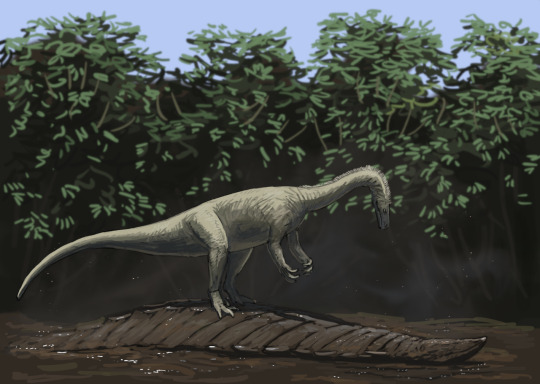
Mystriosuchus alleroq
Now we got our first new species of a preexisting genus. While I did my best to make posts on new genera, which typically went hand in hand with their respective wikipedia pages, species are a different matter since they'd require me to overhaul and research the whole genus. Which for Mystriosuchus would go all the way back to 1896.
Anyhow, Mystriosuchus alleroq ("jawbone spoon crocodile") is the newest in a long line of Mystriosuchus species and has been recovered from western Greenland of all places. Like Colossosuchus it is known from multiple individuals, at least four in fact, And like Venkatasuchus, it appears to have wideraning implications for the spread of archosaurs during the Triassic. Oh look its Josch's art again, neat.
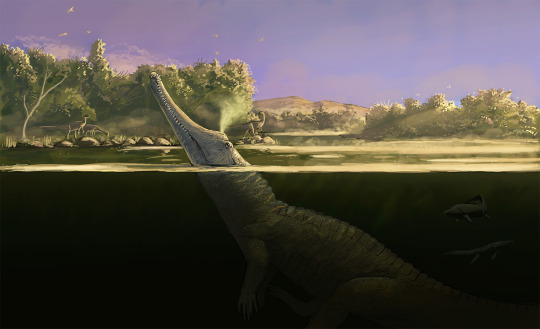
Jupijkam
The final phytosaur and the final Triassic taxon of the year, Jupijkam paleofluvialis ("horned serpent of ancient rivers") was recovered from Nova Scotia Canada and represents one of the northernmost phytosaurs (alongside obviously our friend Mystriosuchus alleroq above). It is far less complete than the other phytosaurs I covered so far, but still nothing to scoff at. It's also one of the youngest known phytosaurs, possibly having lived during the last stage of the Triassic. There's no art but here's an image of its snout from the original paper.

Turnersuchus
And with this we have reached the Jurassic and somewhat of a double feature. Ordering these via chronology makes this almost like storytelling. Turnersuchus hingleyae ("Hingley's and Turner's crocodile") is the oldest and basalmost named thalattosuchian, a group of crocodylomorphs that took to the seas. As such it shows a mosaic of features, already having begun to reduce its limbs, having a moderately long snout and still bearing osteoderms, which some of its descendents would come to lose. Turnersuchus dates to the Pliensbachian, a stage of the early Jurassic, tho the paper mentions how its not likely to hold its title as oldest member of its group for long as even older material has been discovered and is awaiting publication. Artwork by Júlia d’Oliveira and Joschua Knüppe

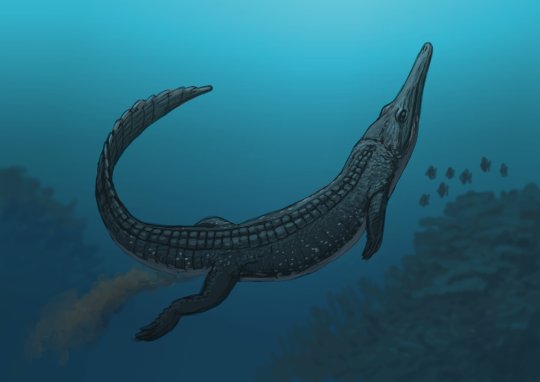
Torvoneustes jurensis
While Turnersuchus gives us a glimpse at what the earliest thalattosuchians were like, Torvoneustes jurensis ("savage swimmer of the Jura Mountains") represents them at one of their most derived. At 4 meters long, it must have been an impressive creature, entirely smooth and lacking osteoderms, highly reduced arms and a tail fluke to boot. There are some interesting features, as unlike other species of Torvoneustes, this one does not appear to have been as durophagous, instead appearing to be more of a generalist. It's the last Jurassic croc of the year and practically lived at the opposite end of this time period relative to our previous thalattosuchian, during the Kimmeridgian. Artwork by Sophie De Sousa Oliveira, not to be confused with Jùlia who drew Turnersuchus.
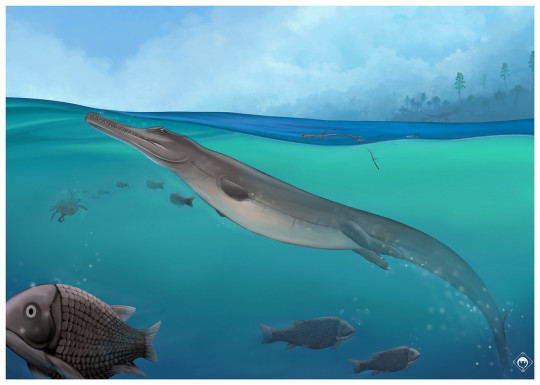
Comahuesuchus bonapartei
From marine to terrestrial, Comahuesuchus bonapartei is a member of the Notosuchia, land-dwelling cousins to the Neosuchia. This new species is known from the Cretaceous of Argentina and was described on the basis of a lower jaw, which differs from the previously described species of Comahuesuchus by the fact that the teeth are situated in individual sockets. Its jaws were short and wide, being described as U-shaped, giving it a somewhat pug-nosed appearance. In case you're wondering why I don't have the translation of the name thats because I can't access Bonaparte's first paper, so all I can say is that the new species is named after famed Argentinian paleontologist Jóse Fernando Bonaparte. Artwork by I mean you probably guessed it, its Josch again.
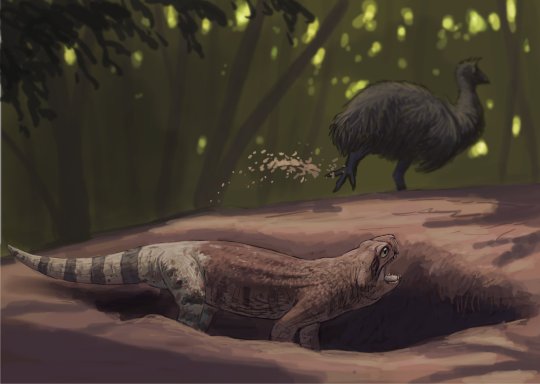
Aphaurosuchus kaiju
I have some mixed feelings on Aphaurosuchus kaiju ("powerless kaiju crocodile"), not just because I have to rewrite its genus wikipedia page that I am no longer happy with. No, Aphaurosuchus is a great genus in my opinion, given the complete nature of the holotype. But I do think that the species name of this second form is a bit of an exaggeration, seeing as it is to my knowledge not that exceptionally big. So why name it kaiju other than to sound cool? I also think it just kinda becoms funny when you consider the meaning of the genus name. Anyhow, it does look pretty mean, but thats to be expected from a baurusuchid. It lived during the Late Cretaceous in Brazil and the phylogenetic analysis that accompanied its description had some interesting implications that I'm curious to see tackled in the future. Other than that it's just another baurusuchid from a place crawling with baurusuchids, which tbh is pretty cool itself but doesn't really help make it stand out. Arwork by Paula Zeinner
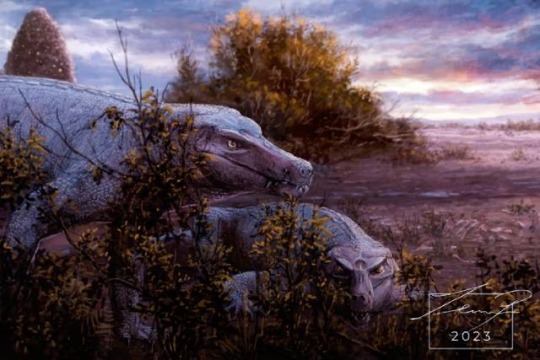
Dentaneosuchus
It is the middle Eocene. France is entirely occupied by mammals. Well, not entirely... One indomitable reptile still holds out against the invaders. Yes, I am of course talking about Dentaneosuchus ("frightfull crocodile"), the titan of the Eocene, the terror of the jungle. Easily among the most exciting finds, this animal was an enormous sebecid previously thought to be a member of the genus Iberosuchus, but recent research not only shows its distinct but enormous. With a lower jaw around 90 cm long, it rivals even the famed Barinasuchus of Miocene South America. The total body lenght is of course a matter of debate given how little we know about sebecid proportions, with the paper lowballing it at 3 to 4 meters and I personally recovering something more akin to 5 meters. Regardless of the specifics, this would make it easily one of the top predators of its time, tho sadly this was not meant to last. It was among the last non-mammalian apex predators of Europe, before climate change and competition from mammals eventually drove them to extinction. Arwork by Joschua Knüppe and @mariolanzas

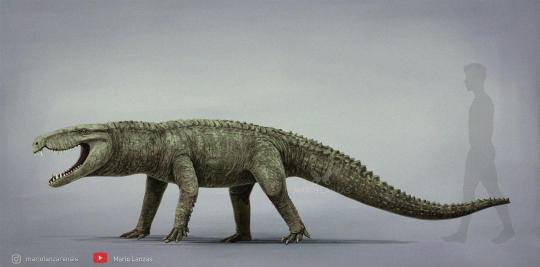
Baru iylwenpeny
Our last three entries were all members of the Notosuchia, the terrestrial crocodiles that existed from the Jurassic to the Miocene, so lets jump to the other major group of the time, the Neosuchians, specifically their most recent branch, the Crocodilians. Yes finally we are getting to crocs in the stricter sense.
Baru iylwenpeny ("divine crocodile thats good at hunting") is an animal we also knew for a while under the informal name Alcoota Baru based on where it was found. This year I spent a lot of time writing in the Mekosuchinae, Australasian crocodiles of the Cenozoic and just when I had finished the page for Baru, this guy got published. It's the largest, most robust and most recent member of the genus. Good at hunting is a good choice for the species name, as this animal was over 4 meters long with a head commonly likened to a cleaver and a hunting style speculated to consist of inflicting a lot of trauma on its prey with its massive teeth. I could gush about Baru for ages, but thats the important parts. It lived in central Australia during the Miocene only 8 million years ago. Artwork by the incredible @manusuchus
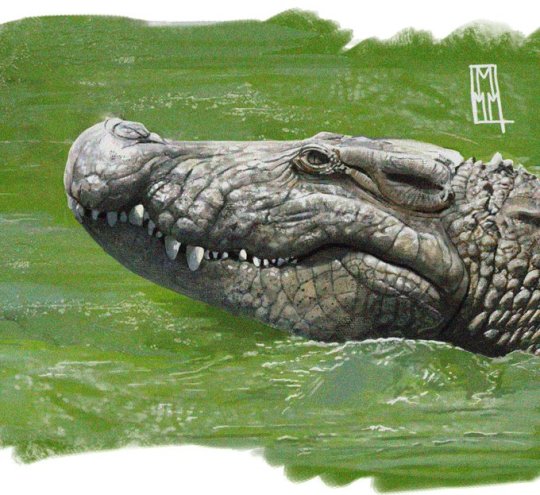
Antecrocodylus
Now for the last crocodilian described this year and one I remised to make a dedicated post for due to time constraints (I had a busy few months). Antecrocodylus chiangmuanensis ("before Crocodylus from Chiang Muan") is a close relative of the modern dwarf and true crocodiles from the Miocene of Thailand. It is only known from the back of the skull and an associated lower jaw, but it serves to highlight how little we know about the crocodiless of eastern Asia during the Miocene, which is a shame given that this region is crucial to deciphering where true crocodiles originated.
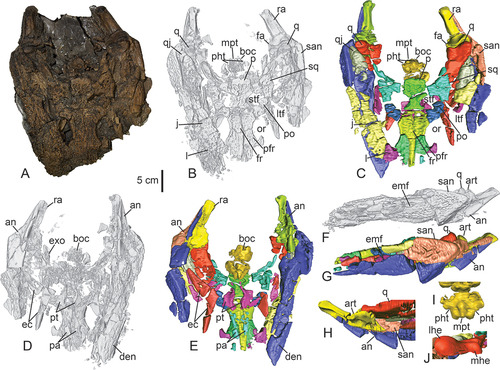
Alligator munensis
And our final taxon is Alligator munensis ("Mun river alligator"), which, obviously, is a member of the modern genus Alligator and thus most closely related to the still extant Chinese and American Alligator. Likely having been split from its Chinese relatives when the Tibetan plateau was lifted up, this species lived during the middle Pleistocene in Thailand and may have survived until the Holocene. It's head was short and robust and its teeth globular, which could indicate that it fed on hard-shelled prey like clams and snails. It was also small, likely not much bigger than 1.5 meters. Artwork by Joschua Knüppe


And that should be all of them, all new species and genera of Pseudosuchians described this past year. It's once again been fun to look back and I hope that you find them just as interesting as I do. Lets hope that 2024 will bring equally fascinating discoveries.
#alligator munensis#alligator#croc#crocodile#pseudosuchia#notosuchia#crocodilia#crocodylus#antecrocodylus#thalattosuchia#torvoneustes#paleontologoy#torvoneustes jurensis#turnersuchus#comahuesuchus#aphaurosuchus#aphaurosuchus kaiju#dentaneosuchus#jupijkam#colossosuchus#palaeoblr#prehistory#kryphioparma#venkatasuchus#mystriosuchus#scolotosuchus#baru#baru iylwenpeny#science
270 notes
·
View notes
Text
yeah, dinosaurs are cool and all, but wheres the love for fucked-up permian and triassic synapsids, temnospondyls, aetosaurs, and rauisuchians??
10 notes
·
View notes
Text
Triassic collision: The high lizards.




During the early jurassic, the coelurosaurs would also diversify but with the rauisuchians around. They would be restricted to smaller forms.
However, the rauisichians would eventually go extinct by the end of the middle jurassic. Finally giving the dinosaurs a chance to once again reign over the earth.
While tyrannosauroids and dromaeosauroids would also evolve during this period, the late jurassic would instead be ruled by a group known as the acrosauroids.
The acrosauroids, also known as the high lizards. Were the first theropods to reach sizes that we would consider big. They would quickly evolve and fill different niches.
The smallest and most basal of the acrosauroids would be the monoceratosaurus (One horned lizard), this is especially obvious by its smaller size and thinner build. Only weighing 1 ton despite being almost the same height and length as the ceratosaurus from our universe. These animals usually prey on smaller prey like deer sized mammaliformes or other coelurosaurs, and are especially known to target the eggs most of the time. One interesting thing about this animal is its single horn on its nose, which is considered to be used for attracting mates.
Then we have acrosaurus (High lizard), which the entire group is named after. Being the most popular and also the first acrosauroid, this animal is iconic for its large sail on its tail. The exact purpose of the tail is still unknown, but its mostly considered to be used for attract mates or for heat regulation and cooling the animal. Acrosaurus was by far the most successful predator of the late jurassic, hunting large herbivores and chasing out other theropods of the area.
However, the largest acrosauroid by far would be gigsaurus (Gigantic lizard). The most interesting part of this dinosaur is its hump or sail on its neck, the purpose of this hump has debated because of its odd placement. Not only that, the hump would have also restricted the animals neck movement. Because of this, it is believed that gigasaurus would have hunted smaller prey or scavenged food. This is also not helped by the gigasaurus's fragmentary nature, with the first fossil ever discovered being mistaken to be an acrosaurus. Not only, the gigsaurus is also believed to be closely related to acrosaurus but this has also been debated. Unless more material is found, the gigsaurus and its hump still stays a mystery.
The final acrosauroid that we are gonna talk about is the carcharosaurus (Shark lizard), what makes this acrosauroid interesting is its aquatic adaptations. As younglings, the carcharosaurus are born with 2 fingers with their third finger having evolved into a fin. But as they get older, their fingers eventually fingers will smaller before completely disapearing. It's believed to have hunted near the shores, lakes, and rivers. Their diet consisted of fish, crocodiles, thalattosuchians, small mammaliformes and coelurosaurs.
3 notes
·
View notes
Note
Okay so. I have sorted them. The dinosaurs (and company). By era.

So first we have Dimetrodon (Purple). Those guys are not dinosaurs, but reptiles from the late Permian period. They are the precursors to Dinosaurs, all that jazz.
Next we have what I think is some sort of Rauisuchian (Orange) from the early Triassic period. Then again it could be an earlier version of Spinosaurus cause at a time scientists thought those were quadrupeds and not bipeds.
Next we have what are not dinosaurs, but some sort of Ichthyosaurs Species (Blue) from the bridge between the Jurassic and Triassic periods. The aquatic reptiles that once again are not Dinosaurs but Ichthyosaurs.
Next we have the Jurassic period itself, with Stegosaurus (Orange), Brachiosaurus (Light Green), and what I can only assume is an Apatosaurus (Dark Green) since i dont have a lot to go off of.
Next we have another two that aren't Dinosaurs, but Pterosaurs. The Pterodactyls (Orange) come on the bridge between the Jurassic and Cretaceous periods.
After that we have the Cretaceous period, the end of the Mesozoic/Age of the Dinosaurs. We have T-Rex (Reddish Brown), then we have Anklyosaurus [Specifically Anklyosaurus Euoplocephalus] (Pink), then Spinosaurus (Yellow), then Triceratops (Orange), and finally we have what I assume is Styracosaurus (Brown), but then again the head spines look a bit weird for that species.
ooooh :0
4 notes
·
View notes
Text
Here’s some of that ultraman fanfic stuff I mentioned
Ultrawoman Nova
Ultrawoman Nova is a 70 meter tall ultra who is a kaiju researcher who loves infodumping and works with a science team to manage an island kaiju nature reserve. She has an adopted pestar Scrungus and a shin Gabora capsule kaiju.
The ultra setting she lives in is one where almost all Ultraman series has happened to an extent, but in a cohesive timeline and mostly follows after the original continuity.
Almost all the kaiju both are and aren’t native to earth’s biosphere. They aren’t in that they descend from various aliens that ended up on earth, and are in that these aliens eventually naturally integrated into the biosphere.
Notable residents of the reserve:
A baby Gatanothor Nova also adopts. Initially Nova had a heart attack when she found it had crash landed on the island because Gatanothors are known world enslavers so she wondered if it’s evil by nature… until it fell on its side and started crying and pooping on itself. Whenever Scrungus goes and plays in the water with a baby takkong and gesura, the baby gatanothor gets upset because it can’t swim and play with them.
An Eleking that chills under a waterfall. He helps feed the Neronga and helps provide power to the island or cities that experience power outages.
A Neronga mother who has cubs (adults look like the shin incarnation while babies look like the showa version). One time it misbehaved and got in a fight with Nova. Kids on a field trip were at the reserve at the same time so Nova took the opportunity during the fight to pin the mom Neronga down facing the children and talk about its teeth while it flailed its arms around. Children may or may not have been traumatized.
A Gubira from the deep sea who keeps trying to move into the burrows of subterranean kaiju on the island despite not being a burrowing creature itself and gets into fights. Nova constantly has to patch up its tube feet.
An Empowered Bemular who sits in a lake and is learning to behave and not be evil. If the space faring abelisaur is good for a week then it’ll get a boat for a toy, but it hasn’t behaved that long yet.
An elderly Red King couple. These Rauisuchians have sexual dimorphism, with males being red (like the powered incarnation) and females having massive forearms (like red king EX). The male is a little weak for his age and is missing numerous scutes and has burn scars from entering burning mode too much. The female also has a few scutes missing, as well as a leg, some fingers, and her tail tip (which like alligators it grew back but it’s mostly connective tissue). Her mandibles were also completely obliterated at some point in her life so it healed kinda wonky.
A pod of Gesura live around the island, and there’s a lot of cocoa trees Nova planted for them. The whatcheeriids love fruit so they occasionally come onto land to eat the cocoa beans. Scrungus plays with the babies in the pod.
A Gimyra. Specifically THE Gimyra defeated by Ultraman 80. He lives in and is confined to a cave due to his evil behavior. He basically sits in a prison while being studied. He’s allowed to take harmless amounts of blood from kaiju on the reserve during night to sustain himself. Lavras and Daron also came with him, but they’re harmless and quite nice and often work with the local science team or babysit Scrungus.
Some kaiju biology:
Neronga are a formerly extraterrestrial kaiju species. Adults look like the shin incarnation while babies look like the showa incarnation. Mothers give live birth to a few Cubs that can already clumsily move around. The mom then charges some of her back plates full of electricity and detaches them. This will be the first meal for the babies. Whether or not the mom takes care of the babies depends on the conditions of the environment. The Neronga at the sanctuary is a mother who’s looking after her Cubs. The fat reserves of the babies can also serve as fuel for their budding electrical abilities when they feel threatened. Individuals have male and female parts and mating involves jabbing their incredibly long thumb claws into each other, which function like needles and deposits sperm. They fight over who gets impregnated much like marine flatworms. Using their electrical powers they can bend light around their body and become invisible. To make up for their lack of a tongue their gums also function as taste buds.
Red Kings are big Rauisuchians and are massive predators known for their size and strength as well as their impenetrable full body covering of scutes. They also have some big saber teeth as well. Males look like the male red king in powered and females have big arms like the EX incarnation. They have a dome head much like pachycephalosaurs, and they have been known to swing their heads around, which are backed up by their long overly muscled neck. Their saber teeth are long enough to go past their jaw line and are positioned near the back of the mouth. This makes them useless for biting but instead useful for cutting when they swing their heads around. Their bite is also very powerful. When under significant stress they can enter a burning mode that turns their skin black and makes the spaces in between their armor glow with thermoluminescence, but this is a last resort that not only completely exhausts an individual, but also injures them greatly. Sometimes even dying. Red king will mate for life and heterosexual couples will lay eyes every few years. The eggs are guarded fiercely, but once the young are born they’re on their own. Individuals can be identified from their scars not unlike great whites.
Dorako are aliens that aren’t one of the many species that has integrated into earth’s biosphere, making it a proper invasive species. Their wings are large and able to fold up like some more advanced insect wings. Their arms are more like the powered incarnation. Dorakos have both an endoskeleton and exoskeleton and are surprisingly powerful for their size. Their respiratory system is in their abdomen (tail) and there are many spiracles as well. Take off is assisted by a massive exhale from the spiracles. Over their life as they grow in size they do have to molt, but their exoskeleton comes off in pieces and doesn’t require them to do a full body shed. Once they’re adults they don’t molt again. Initially they were thought to come from comet Tsuifon, but after more information was brought to light thanks to the ultras it turns out that their original habitat is unknown and that they have evolved to become an interplanetary invasive species. The find a planet that has an atmosphere they can breathe and then assert themselves as an apex predator. They then reproduce asexually until they reach the threshold that the ecosystem they’re occupying can support, after they reach that threshold they engage in mating to diversify the gene pool and then most of them leave to find other planets and start the cycle again. Dissection of Dorakos that have come to earth has revealed that the spike on their forehead can be launched like a bullet, but doing so kills them since their brain is right behind. So it’s inferred that they only start using this after reaching a certain population size.
Gomora are large predatory ceratopsians and very distant relatives of psittacosaurus. Their stomach scutes are derived from feather quills and they are solitary in nature.
Zambolars are large omnivorous solitary squamates that are part of a unique squamate family (informally known as the slurpasaurs). They’re generally subterranean and reside in the hollow earth tunnels. Under normal circumstances their metabolism is fairly sluggish, but when aggravated (like say a territorial dispute) or during intense activity they can drastically spike their metabolism. Their large intricate series of crests helps them regulate their temperature during bouts of activity, and hot blood is pumped through these crests to cool off. (Taking a cue from powered zambolar’s design) these crests have multiple grooves and folds that increase surface area. Sometimes they get so hot that they can set fire to their environment and even use this as a thermal attack. Damage to their own body is mitigated thanks to heat resistant proteins.
Backacoon is a rather strange creature and not much is known about it since only one has ever been encountered. Multiple theories exist as to why the defensive form looks the way it does. Theories range from convergent evolution with vertebrates, horizontal gene transfer from vertebrates, magic, or some other odd phenomenon. It has a rudimentary internal skeleton made of chitin, and its teeth, claws, and horns are made of chitin too. Much like the unrelated cordyceps fungus, backacoon needs to parasitically infect arthropods to progress its life cycle, but is incapable of infecting anything else. Inhaling the spores can make you sick though.
Gudon is another former-alien-become-natural-species. Much like Dorako, Gudons have both an endo and exoskeleton, but their endoskeletons aren’t as extensive as you’d think. Only appearing in the limbs, limb girdles, head and neck, and back. Also their biomineralized exoskeleton isn’t able to be shed in pieces, so a full molt is required. They’re an aggressive predatory species and the main predators of twintails, which a population of the ancestral species of twintails came to earth with the ancestral gudons on their tail. Their jaws and teeth are pretty weak so in order to tear apart prey for consumption they impale them on their spikes and horns and tug at them with their arms until they get pieces that can be swallowed. Leftovers are also skewered on their spikes as well. They smell things with their one nostril and their sense of smell is pretty strong too. Their whips can taste and they’re covered in microscopic metallic barbs that make picking up scraps of meat easier. Reproduction is carried out by their whips. One of their whips starts to fill with gametes and detaches. It then seeks out another detached whip and the two fuse together. Then a bunch of baby Gudons hatch from each segment. Most don’t reach adulthood.
The evolutionary history of Telesdon can be traced back to planet Boris. The ancient ancestors of telesdon resembled worms with five tails, but over time four of those tails became limbs and even grew bones. Their head also evolved through the fusion of their first two body segments. With the first segment forming the cranium and the second segment forming the mandibles. Their body is covered in small studs that aid in their burrowing. While they can dig with their limbs, they normally dig using rhythmic muscle contractions and relaxations. The studs grip the earth and pull them forward during this movement. Despite being predators, telesdon fall prey to many other kaiju. If fighting isn’t an option they will attempt to dig away. If they’re getting pulled out, their spike will dig into the soil and hook them in place. Telesdons are hermaphrodites much like actual worms, and their reproductive organs are located in their torso segment.
Kemular are another former extraterrestrial species. They spend most of their time burrowed in the dirt with only their two back plates exposed for photosynthesis. They also absorb nutrients from the ground through folds in their skin. Occasionally they need to resurface and eat food though. This is accomplished by flooding an area with toxic gas and scooping up the dead wildlife with a long prehensile tongue. Their tails can also shoot arcs of electricity as well, but this is weak and it seems like the organ is becoming vestigial as its no longer necessary since the gas they produce has become increasingly toxic. Their brain is flat and located on their back. Because of the placement and the relatively long and flat anatomy of their brains, it gives the appearance of their brains being far larger than they actually are. Damage to the brain can actually cause severe neurological problems and can often cause death. Because their brains aren’t in their skull, their gas organs are located there instead. Reproduction is carried out by spores, which are fired from groves in the brain on the back. These spores settle down and eventually grow into new kemulars.
Pestars are former extraterrestrials and have become an incredibly successful abyssal species complex and predators. They are very similar to echinoderms anatomically, and there exists a great deal of individuality when it comes to appearance. Pestars initially start life gorging on petroleum and other sources of hydrocarbons before switching to meat and only occasionally consuming hydrocarbons to fuel their fire breath. They are important predators of takkongs and gubira, which they sneak up on in the abyss and physically pull apart with their powerful arms and clawed tube feet.
Gubira are a former extraterrestrial species. They’re bottom feeders who eat creatures they stir when sifting through the seabed. They use their drill zooid to break through tough material. It’s legs are giant tube feet that are fed water through a sieve plate on its forehead that can also shoot water in self defense.
Magular is another slurpasaur
I’d reinterpret Geronimon as a maniraptorian
Goldon is a titanosaur
#Ultraman#ultrawoman nova#kaiju#speculative zoology#speculative evolution#speculative biology#speculative ecology#speculative anatomy#pestar#red king#neronga
7 notes
·
View notes
Text
Depends on the kind of dragon.
A four-limbed dragon - a wyvern, a traditional drake, a lung, even a wyrm that's secondarily lost its limbs - could very well be. Animals like Yi qi were already experimenting with dragon-like wings back in the the Cretaceous, and a descendant of theirs could have tended towards gigantism, carnivory, and increased intelligence. However, personally, a lot of dragons would be more likely to be related to crocodiles, specifically rauisuchians like this fellow:

Give him a hundred million years or so as the apex predator, and something draconic isn't out of the question, as long as it doesn't lose its forelimbs the way theropod dinosaurs tended to.
A six-limbed dragon, however, like the traditional Western kind, would have to come from a seperate lineage of vertebrate evolution. There's actually no real reason why tetrapods have four limbs - the most successful lobe-finned fish that crawled up on land simply happened to. Six-limbed lobe-finned fish exist, and if some of them managed to get a foothold, six-limbed animals would follow - though they'd likely look very different from traditional tetrapods. Assuming a bit of convergent evolution, though, converting one of those pairs into wings is a very reasonable evolutionary strategy, leaving two sets left over for walking, or one for walking and one for manipulation. That implies that the closest relatives of dragons are griffins, pegasi, manticores, and similar creatures - any quadruped with six limbs and wings. Why those animals would convergently evolve into things that look like tetrapods is another question, but it's almost certainly not a perfect 1:1 correlation, and more looks that are similar by chance.
In settings where dragons exist and dinosaurs exist/existed, are dragons a form of dinosaur, like birds?
122 notes
·
View notes
Text

Credit me if you use this
0 notes
Text

Críptido del día: Gbahali
Descripción: El gbahali es un críptido encontrado en los ríos de la selva tropical del condado de Lofa en Liberia , particularmente en el río Kahai. Descrito como un gran reptil anfibio con aspecto combinado de cocodrilo y de lagarto monitor, puede crecer hasta 9 metros de largo con la espalda cubierta por tres filas de armadura dentada, un hocico corto con dientes grandes y una cola poderosa. Según varios informantes su cabeza se parece más a la de un lagarto monitor que a la de un cocodrilo. Las descripciones son similares a las del Rauisuchian Postosuchus que se extingio hace 200 millones de años pero vivio en el territorio actual de Estados Unidos. El gbahali es considerado peligroso y agresivo, y se dice que ha matado gente en el pasado. Se dice que tiende una emboscada a su presa desde el río y arrastra al animal bajo el agua para ahogarlo, pero se come el cadáver de la presa en la orilla del río. Durante la temporada de lluvias, cuando se les ve con mayor frecuencia, se desplazan río arriba en busca de alimento.
1 note
·
View note
Note
I’ve always enjoyed the Idea of parasaurolophus or maiasaura as cattle, peacefully gracing with a shepherd nearby, if you still take dino prompts ❤️

Dinovember Day 15: The Herdsman
334 notes
·
View notes
Text
THISS!!! Also Suchonization is super underrated too, so many tetrapods just decided to become crocodiles. Temnospondyls, Champsosaurs, Proterosuchians, Phytosaurs, hell even Ambulocetus did it, and I'm sure there's even more i'm missing... hell one could argue to a lesser extent even Gar and Rhizodonts are partially suchonized depending on one's definition. Also on a related note, there's in turn a thing where Psuedosuchians in particular keep trying to become fast running dudes, happens so many times lmao, Rauisuchians, Poposaurs, Sebecids (and some other Notosuchians), Mekosuchians, to a lesser extent Mahajangasuchians, hell even Cuban Crocodiles are pretty good at running.
None of these things imply the thing transitioned from is lesser or bad, given many of them still exist - and none imply the thing transitioned to is better or good, given many examples of each often go extinct regularly :)
627 notes
·
View notes
